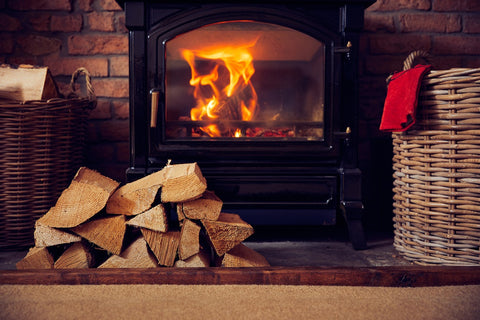
Impact of wood burning stoves on indoor air quality
Share
You may well have seen over the Christmas period a number of newspaper articles about wood burning stoves and indeed a number of you actually emailed us to ask for our views.
As members of the Stove Industry Alliance (SIA) and with myself playing an active role on the Exec committee, we understandably monitor these articles and will act accordingly.
What articles have been published about wood burning stoves?
One article was based on a report published by ‘Atmosphere’ on 7th December by Sheffield and Nottingham universities entitled ‘Indoor air pollution from residential stoves’ and most recently an article in most of the major nationals in which the British Lung Foundation and Asthma UK (now a combined organisation) added their voice to the mix and Dr. Nick Hopkinson, medical director of Asthma UK was quoted in the articles as saying “To protect yourself and others …, avoid buying a wood burning stove or using an open fire if you have another source of fuel to cook and heat your home with”
As with every industry, there will always be someone or some organisation that picks up on a bit of research and tries to take a swipe and I am sure this will not be the last time, but as with all these things it is important that we take on board the comments and respond accordingly and look to work more closely with such organisations and make sure the facts are clear.
Misconception: Wood burners cause around 40% of outdoor particular matter

The latter articles once again quotes “We know that burning wood and coal releases fine particulate matter (PM2.5) – the most worrying form of air pollution for human health” and that around 40% of outdoor particulate matter is caused by woodburners, coal fires and open fires.
Are all negative articles about wood burning stoves true?
If you have read my previous articles, you will already know that this fact is completely wrong and more accurately is likely to be less than 10%. Have a quick watch of this video to clearly understand the misconceptions that are still flying around the media despite Defra agreeing that the figure is incorrect! - https://youtu.be/9VQnSgquvp0
Also, important to note on this point is that at present more than 50% of wood is still burnt on a 10-year old stove or open fire. If these appliances were converted to modern Ecodesign or clearSkies approved appliances, the emissions would be reduced by at least 45% to a level less than 5% of overall emissions.
What university studies have been undertaken on wood burning?
The articles from Sheffield and Nottingham Universities reported in the ‘Atmosphere’ publication appear to have some fundamental problems in respect of lacking a basic understanding of the operation of a wood burning stove. There are also other factors that will influence indoor air quality within the house and their comparative scale of creating particulate matter, and they draw emotively worded conclusions that are not supported by the evidence provided.
Furthermore, the air quality monitors used in the research were “low-cost” and their accuracy is highly debatable. The report itself identifies the accuracy of the equipment used and the fact they weren’t calibrated at all during the collection of the data as a potential limitation of the research. Given this fundamental point, it is hard to understand how the research reaches such firm conclusions, when the data accuracy is questionable.
Throughout the report the phrase “flooding” of particulate matter is an emotive one and not one based on scientific fact. It clearly suggests a predetermined outcome being justified, given the facts presented do not support the conclusion.
The research does not address the building regulations requirements for a specified number of air changes per hour in habitable rooms and does not measure whether appropriate ventilation was in place.
What other factors affect particulate matter in the home?

The research doesn’t seek to explain how other factors influencing indoor air pollution have been excluded to sufficiently separate out the impact of a wood burning stove. For example, the fact the indoor air pollution arises between 6pm and 10pm is taken as clear evidence that this pollution comes from the stove. However, this is also typically the time of maximum human activity and movement in a home which will contribute to indoor air pollution, and activities such as cooking, using the toaster, burning candles etc.
What else contributes to particulate matter in the home?
There is also no comparative data presented in the research for other causes of indoor air pollution such as:
- Cooking, particularly roasting or frying
- Using a toaster
- Cleaning – particularly dusting or hoovering
- Use of indoor candles
- Use of aerosols
How do levels of particulate matter in the home vary so much?
Previous research has indicated these create far higher peak levels of indoor air pollution than a modern Ecodesign compliant stove.
Interestingly in February 2016 and again in Oct 2018, Harry Wallop wrote articles in the Telegraph and Times where he borrowed instruments to measure the PM2.5 particles during his everyday activities. Government guidelines suggest that a reading below 35ug/m3 is ‘low’; by contrast, ‘very high’ is above 72ug/m3.
His home had a steady reading of between 18ug/m3 and 22ug/m3 – well within the limits but proof that a normal person’s home is full of far more dust, soot and rubbish than one thinks.
On the tube trip to work, levels did not fall below 125ug/m3 and when the doors opened at Kings Cross, it peaked at 309ug/m3!
His wood burning stove, albeit not the latest Ecodesign compliant stove was reading a steady 42ug/m3 but as he only used it at weekends he had little concern. However, when he burnt the toast, the reading spiked at 10,000ug/m3 and even an hour later it was still above 300ug/m3.
In his later article it was the cooking of the bacon that really raised the reading and way higher than his wood burner.
“We must look at the bigger picture.”

It was also heartening to read a more positive article in the Telegraph on 28th December in which Jessica Salter wrote an article entitled ‘Sales of log burners are booming – and they can still be eco-friendly’. In addition the Guardian recently printed a readers letter in which a Mr Peter Perry from Cornwall makes a very valid point that we must look at the bigger picture. He wrote “undoubtedly if we look closely enough, there are negatives in using wood burning stoves for domestic heating, but there are also many positives, and we need to hear the whole story. So, I’m hoping that, in due course a second study will carefully assess and quantify the benefits, both physical and emotional, and that these will be duly reported by the Guardian”.
So, in addition to the more efficient stoves and the government drive to ban coal and the sale of wet wood, the SIA is keen to commission further research into indoor air pollution to get a true picture.
What advice is available as to how to minimise any indoor air pollution from a wood burning stove?
In the mean-time the SIA offers the following advice on further steps a homeowner can make to minimise any indoor air pollution from a wood-burning stove:
- If possible, install an Ecodesign compliant stove or even better one with a certified clearSkies label as explained above
- Ensure you burn only dry wood, such as “Ready to Burn” certified kiln dried wood
- Only refuel your stove when the logs have been fully burnt and the fire-bed is down to embers
- Open the stove door by a small amount and pause, allowing the air pressure to adjust to the room, before slowly opening the door to allow re-fueling
- Do not overload the stove and follow the manufacturer’s instructions
- Ensure your room is properly ventilated in accordance with Building Regulations
N. Snell
5th Jan 2021
11 comments
I have asthma and I also use a log burning stove. I burn only kiln dried logs from Certainlywood. For interest a year ago I purchased a “Flow” personal air monitor instrument, which measures NO2, VOC, PM10 and PM2.5 levels. You can get an instant readout of these 4 levels, plus the historic time series measures through the day, all readable on iPhone apps. I have made many studies of the effect of lighting, running and refuelling my stove on the air quality measurements in my house, particularly in the room in which the log burner is located. I have found this to have an almost negligible impact which makes little or no change to the readings, and with the air quality level remaining in the green “low” category even during long multi hour burn with several refuelling events (stove open momentarily to add logs). This is in absolutely striking contrast to other household activities, of which by far the worst is running the toaster for 5 minutes (and only browning not burning toast), cooking anything in the oven, and worst of all any sort of frying or grilling, all of which send then measurements of PM10, PM2.5 and sometimes VOC skyrocketing into the highest “purple” (above “red”) level, and without opening a window these levels persist for over an hour after the cooking ends. Other activities I have found that raise levels into the “orange” or “red” are vacuuming, and some types of cleaning sprays. I say all this as an amateur, and clearly my measurements are not part of a controlled scientific experiment, but I have repeated them many, many times and find the same result, namely the log burner makes very little or no impact on the air quality in my house, while other tasks that I do daily, especially cooking, have a huge negative impact.